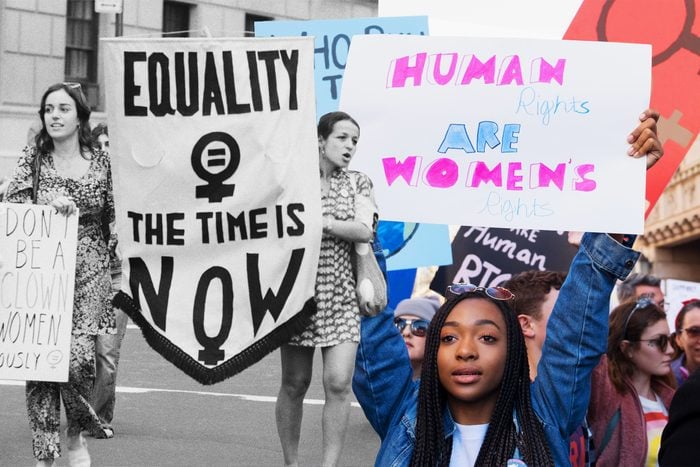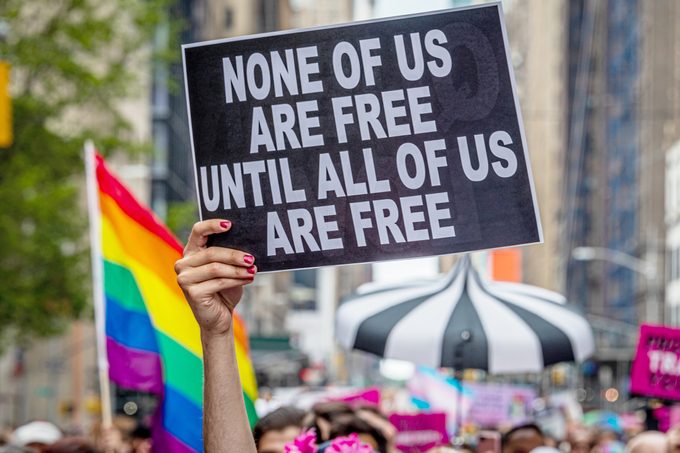The War on Women’s Rights: Why It’s More Dangerous Than Ever, and the Best Ways to Fight Back
Updated: Mar. 13, 2023

Women still aren't guaranteed equal rights under the U.S. Constitution. In the words of Zakiya Thomas, president and CEO of the ERA Coalition, it's high time that changed.
Truck Nuts—yes, those gross fake testicles that some people like to hang from their trucks—have more legal rights in the United States than Dolly Parton, a gem of a human being and, frankly, a national treasure. How can this be, you ask? It’s (maddeningly) simple: Truck Nuts is a corporation. Dolly is just a woman. This is why the ERA Coalition created Woman Corp.
As a corporation, Woman has more rights than women and is “the only woman the government will fight for.” This may sound like semantics, but it highlights a critical fact: Even though there have been some impressive female firsts, women are still not equal to men, and that’s why we need the Equal Rights Amendment (ERA) now more than ever.
The ERA was created in 1923 to ensure women would have equal rights to men (and hopefully at least as many rights as a corporation), and the purpose of the ERA Coalition is to continue the fight to get it formally added as an amendment to the U.S. Constitution. With the Supreme Court overturning Roe v. Wade and midterm elections putting women’s rights on the ballot, it’s important for everyone—no matter their gender—to understand the history and learn how to support the fight.
Get Reader’s Digest’s Read Up newsletter for social justice, humor, cleaning, travel, tech and fun facts all week long.
Wait, women aren’t already guaranteed equal rights in the Constitution?
In a recent survey conducted by the ERA Coalition, 85% of Americans said they thought women’s rights were already guaranteed in the U.S. Constitution. Unfortunately, that isn’t true.
Even though the Declaration of Independence says “all men are created equal,” legally speaking, that only applies to, well, men. We currently have many big legal issues that are still segregated by sex, including the laws regarding employment, property and divorce.
Yet 94% of survey respondents—including men—said they support the ERA. So why, 100 years after its creation, hasn’t it been added to the Constitution?
First, a history lesson
The ERA was first proposed in 1923 as a way to guarantee equal, legal rights for all American citizens regardless of sex. Let’s bust one big myth right out of the gate: The ERA isn’t meant to bring down men or force women to fight in combat—two common misconceptions. The goal of the ERA is to end legal distinctions on the basis of sex so all people will be treated the same under the law when it comes to pay, property, pregnancy, employment, gender-based violence and other areas in which individuals are treated differently because of their sex.
The amendment has been introduced in every single session of Congress since 1923, and in 1972, Congress finally passed it. The move changed women’s history, no doubt, but that was only the beginning of the battle.
To add an amendment to the Constitution, at least 75% of states (or 38 out of 50) must ratify it. By the 1982 deadline imposed by Congress, only 35 states had ratified the ERA—three votes shy of what it needed to pass.
But the goal of equality had never been forgotten, and the cause was taken up in earnest again in 2017. That year, Nevada became the 36th state to ratify the ERA, the first state to do so since 1977. From there, Illinois and Virginia followed suit, finally reaching the 38 states needed to add the ERA to the Constitution.
Success … right? Not so fast. Unfortunately, because the deadline had expired, the process is now tangled up in the judicial system as courts try to decide what the deadline actually meant, if it can be extended or if the process has to start over—and what power individual states have in the process—among other complicated issues.
Equality shouldn’t be a technicality
While the legal jargon is complicated, the bottom line is that the concept of equal rights isn’t complicated. And the longer we wait to codify that into law, the more we are in danger of losing the rights we already hold.
We saw that with the recent Supreme Court ruling, Dobbs vs. Jackson. It took away reproductive rights from millions of Americans and called into question what protections currently exist under the Constitution.
Equality matters now more than ever

The overturning of Roe v. Wade may be the driving factor behind the country’s focus on women’s rights, but it’s not the only reason the topic is at the forefront of Americans’ concerns.
Gender equality is on the decline in the United States, according to a 2017 report from the international Organisation for Economic Co-operation and Development (OECD). Among the issues the organization highlights: the wage gap that sees women earning less than men, and high child-care costs that often impact women the most. “The high cost of child care in the United States has depressed female labor force participation, as women—who on average earn less than men—tend to be the ones to drop out of paid work when child-care costs outweigh wages,” it states.
And that’s saying nothing of the rights of the LGBTQ+ community. Across the country, lawmakers have introduced dozens of bills that target the rights of transgender people. As a Columbia Law School policy brief points out, the ERA doesn’t just focus on women; it has an inclusive definition—equal rights for all, regardless of sex—that “encompasses sexual orientation, gender identity and expression, and others.”
What we can do today
To call attention to both the absurdity of our current situation and the importance of resolving this issue, the ERA Coalition started Woman Corp. You can support the ERA Coalition’s mission and help boost the ERA by:
- Sharing this information with your friends and loved ones (this hilarious video is the perfect way to start the conversation!)
- Connecting with Woman Corp on LinkedIn and adding it to your LinkedIn profile (feel free to make up any job title you like—mine is currently Chief Outrage Officer)
- Becoming an activist in your community and fighting for change on a local level, the way amazing women in history did
- Contacting your senators and telling them to fight for the ERA
- Exercising your right to vote
- Donating money to the cause
But whatever you do, do something. Too many people have become complacent, thinking that women don’t need “formal” rights under the law and that we are already protected. We are not, and the past few years have shown how easily our rights can be taken away from us.
We are not helpless in this fight, and we cannot give up. Do it for yourself. Do it for every woman you care about. Heck, do it for Dolly! We’re all worth so much more than Truck Nuts.
Sources:
- Zakiya Thomas, president and CEO of the ERA Coalition
- Woman Corp
- Equal Rights Amendment
- U.S. Supreme Court: Dobbs v. Jackson
- Washington Post: “The ERA and the U.S. archivist: Anatomy of a false claim”
- OECD: “The Pursuit of Gender Equality: An Uphill Battle”
- Columbia Law School: “The Equal Rights Amendment and the Equality Act: Two Equality Measures Explained”


